The Rise of Multi-CMS, WordPress, and Headless in the Enterprise
More than ever, enterprise organizations need to deliver exceptional digital experiences. Brands today face the challenge of unifying their identity across countless channels while keeping pace with soaring consumer expectations, especially among younger consumers.
Modern websites require lightning speed and near limitless scalability. Users have come to expect every interaction to feel personalized and tailor-made, without sacrificing security or reliability. For an enterprise organization, the content management system (CMS) it uses can make or break the digital experiences it’s able to provide.
Meanwhile, the need for speed has never been greater. The most valuable asset in today’s digital age is time, and as it’s become more precious, consumer patience has diminished, leaving businesses with even less time to respond to market demand. Constantly evolving technology, and our always-on, always-connected lives, drive these expectations, and customers today expect that everything will be instantly available at any time they please.
As these dynamics continue to shape the digital landscape, the CMS landscape itself has also undergone considerable change. Many organizations are now working strategically with multiple CMSs in unison to keep up with the fast-paced digital expectations of their customers and to drive even more effective website design and end-user satisfaction.
Within this trend, CMSs are being used in different ways. Traditional use cases for CMSs are still highly relevant, but newer approaches, such as headless configurations, are being used by a growing number of organizations looking to complement traditional strategies and realize a new host of benefits. All are responding to market dynamics and the imperative to be both more agile and far quicker to market.
This report, which is a follow-up to a similar survey conducted in 2017, explores the rise of multiple CMS use in the enterprise, how IT and marketing decision-makers view their current options, and what the future might hold for the CMS market and the digital experiences of tomorrow. We’ve also covered the topic in a webinar, which you can view here: Multi-CMS Webinar.
Key Findings
WordPress is one of the most widely-used CMSs among enterprise organizations.
- Adobe Experience Manager (AEM) remains the most commonly used CMS overall (68%), but WordPress is neck-and-neck with it (66%). In the secondary CMS market, WordPress has double the lead over AEM (28% vs. 14%).
- WordPress use in the enterprise has risen more than any other CMS since 2017 (16%), driven largely by the rise of multiple CMS use.
- Security (46%), analytics (46%), and scalability (44%) are the top three factors for choosing WordPress.
The benefits of using WordPress as a primary or secondary CMS are becoming increasingly clear.
- IT and marketing decision-makers share widespread awareness of the benefits that come from leveraging WordPress. Even among those who do not necessarily use WordPress, 95% can highlight at least one of its primary benefits.
- 31% of respondents viewed ROI as a major benefit of using WordPress; the average for all other CMSs was only 20%.
- The use of multiple content management systems continues to rise.
- In 2017, just over half (53%) of respondents’ organizations were using at least two CMSs. Today, three in five (60%) use multiple CMSs—an increase of 13%.
Headless is here.
- 53% of enterprises are currently using a headless approach.
- 80% of enterprises that do not currently use a headless approach said they would be evaluating the use of headless technology within the next 12 months.
- Among respondents whose organizations use WordPress, one in four (25%) point to headless applications as one of its primary benefits.
Multi-CMS use appears strong moving forward.
- 49% of enterprises are planning to expand to additional CMSs in 2020.
53% of enterprises are currently using a headless approach.
A Tale of Two Platforms: CMS Use in the Enterprise
Going as far back as the 1990s, software providers have offered solutions that allow users to build and maintain content on the web. While early iterations of these platforms were limited, they paved the way for the more functional content management systems that followed.
Today, some of these systems have become complex, proprietary (licensed) solutions used to power the entire digital presence of large-scale, enterprise organizations. Others, that sprung up from open source projects like Drupal, Joomla, and WordPress, have also enjoyed popularity, although historically not always at the enterprise level. That trend, however, is rapidly changing.
Today the two most widely used CMSs in the enterprise are Adobe Experience Manager (AEM), a proprietary system with a reputation for high cost and heavy IT involvement, and WordPress, an open source (unlicensed) CMS that has helped democratize web development with open code and widespread integrations.
The dominance of these two platforms does well to illustrate the current CMS ecosystem, which is increasingly divided between the legacy, vendor-centric platforms, and more open, agile systems that make it easier for businesses of all sizes to respond to market trends faster.
This split was clearly visible among survey respondents—68% said they use AEM while 66% said they use WordPress. While both platforms continue to see an increase in usage over time (AEM sat at 60% in 2017 while WordPress sat at 57%), WordPress has witnessed a greater percentage increase. In fact, WordPress has seen a greater percentage increase over time than any other CMS and is on track to become the first choice for enterprise organizations.
This split was clearly visible among survey respondents—68% said they use AEM while 66% said they use WordPress. While both platforms continue to see an increase in usage over time (AEM sat at 60% in 2017 while WordPress sat at 57%), WordPress has witnessed a greater percentage increase. In fact, WordPress has seen a greater percentage increase over time than any other CMS and is on track to become the first choice for enterprise organizations.
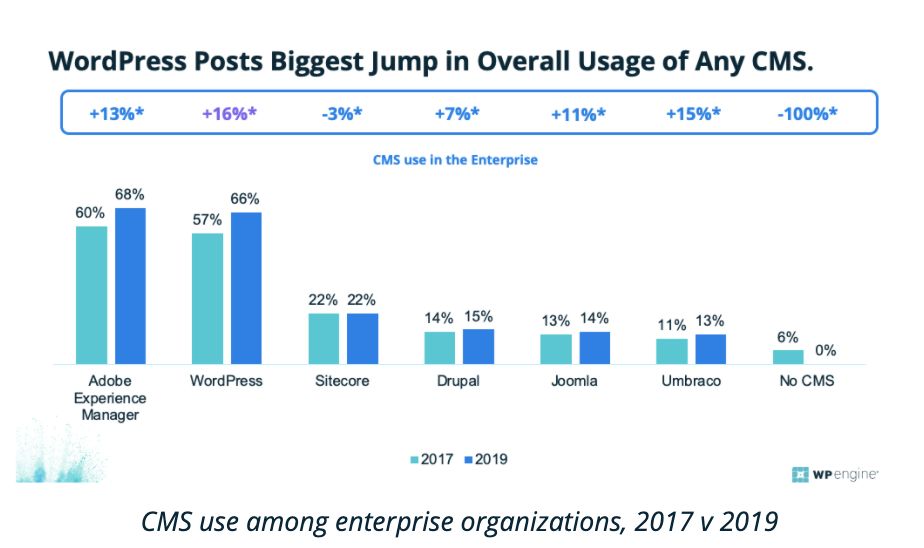
Why does the enterprise use WordPress?
Open source technologies, more than other solutions, have had to prove themselves in the enterprise, and WordPress is no exception. For many years, the notion that “something without a license couldn’t be good” prevailed when it came to large-scale global web projects, and proprietary solutions such as AEM and Sitecore were commonly considered “safe” bets.
But times have changed, drastically, and as new technologies and younger audiences have ushered in the need to go to market even faster—a place where open source technologies shine—usage of WordPress in the enterprise has increased.
Today, WordPress powers more than 35% of the entire Internet and it is by far the most popular CMS with 60% of users choosing it over other CMSs. This is due in part to the ease-of-use WordPress has become known for, but ironically, it’s also because WordPress is open source, and supported by a dedicated community of collaborative developers constantly contributing to its core software. Proprietary solutions are unable to offer that type of community approach. This is why open source, more broadly, has transformed the way software is built and implemented. WordPress’ success in the CMS realm is no different. Today, the WordPress ecosystem is home to an extensive, growing list of plugins and themes—built by thousands of different developers—that offer endless ways to customize and add new features to WordPress-built sites.
Today, WordPress powers more than 35% of the entire Internet and it is by far the most popular CMS with 60% of users choosing it over other CMSs. This is due in part to the ease-of-use WordPress has become known for, but ironically, it’s also because WordPress is open source, and supported by a dedicated community of collaborative developers constantly contributing to its core software. Proprietary solutions are unable to offer that type of community approach. This is why open source, more broadly, has transformed the way software is built and implemented. WordPress’ success in the CMS realm is no different. Today, the WordPress ecosystem is home to an extensive, growing list of plugins and themes—built by thousands of different developers—that offer endless ways to customize and add new features to WordPress-built sites.
Another factor that’s won over the enterprise is the functionality of WordPress itself, which has greatly expanded in recent years thanks to rigorous development, access to powerful APIs, and increased adoption by the enterprise. Today, WordPress is the go-to solution for organizations of all sizes looking to quickly build anything from corporate websites and brand or product pages to headless configurations and eCommerce stores—WordPress simply offers the ability to quickly create a wide range of digital experiences that help businesses differentiate online.
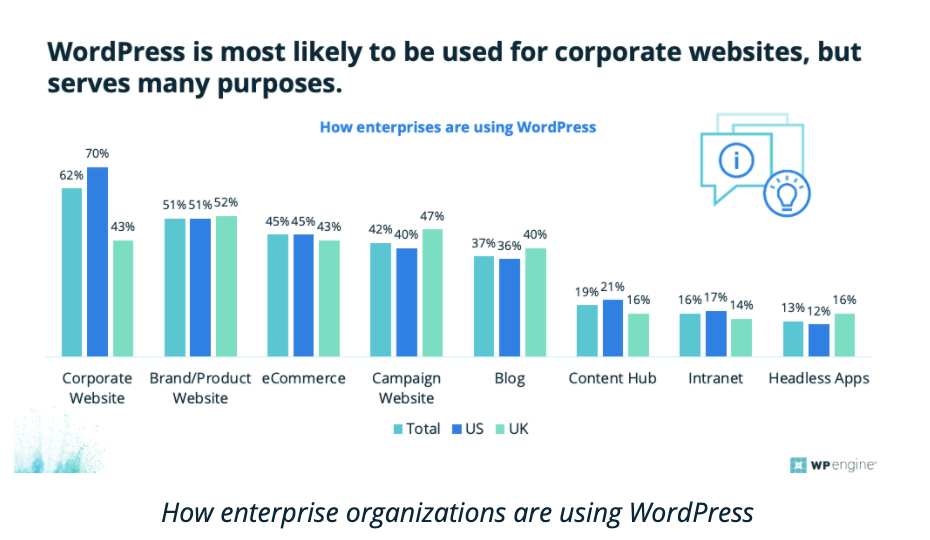
In the enterprise, WordPress use has risen more than any other CMS since 2017 (16%), and among enterprise-level IT and marketing decision-makers, there is also now widespread awareness of the benefits WordPress can provide. In fact, even among survey respondents who don’t necessarily use WordPress themselves, 95% were able to highlight at least one primary benefit of using WordPress. When looking only at respondents who are WordPress users, the evidence of these benefits becomes even more clear.
WordPress use has risen more than any other CMS since 2017 (16%).
Security (46%), analytics (46%), scalability (44%), time to market (41%), and ROI (38%) are just a handful of the primary benefits recognized by survey respondents, illustrating the far-reaching capabilities of WordPress as a CMS.
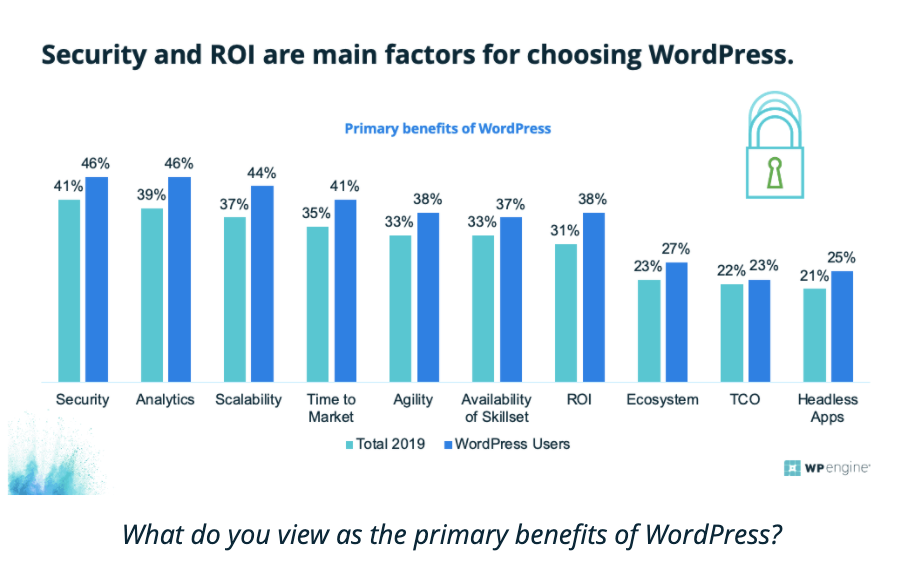
WordPress is also a platform that can be used by anyone—not just those with a technical background. Among organizations that use WordPress, members of the marketing department (72%) are the most likely users, closely followed by IT (68%). Beyond that, sales (42%), finance (31%), and customer support (18%) functions in organizations are utilizing WordPress too—further underscoring its usability.
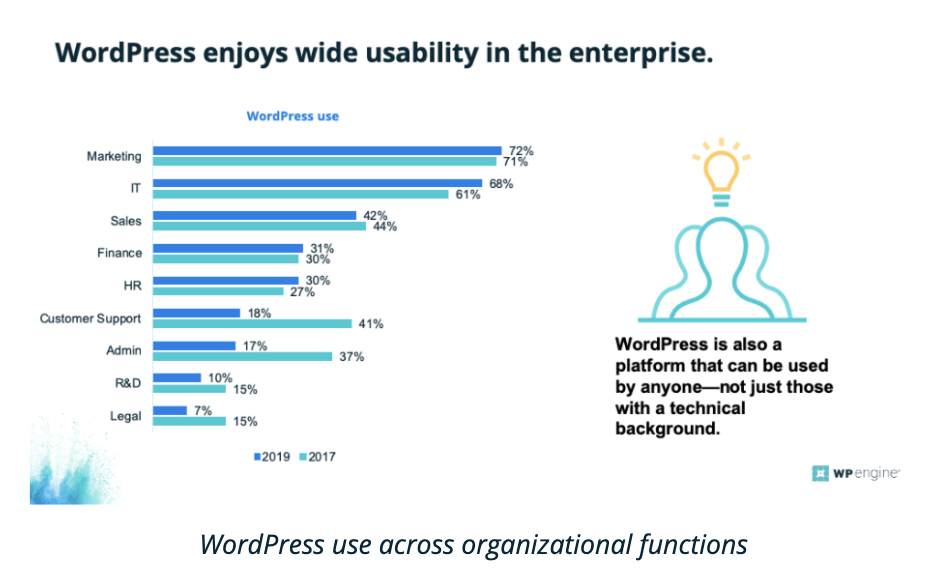
The Rise of Multi-CMS
Historically, organizations using a CMS relied on a single solution, be it AEM, WordPress, or another platform. As the trends outlined earlier have played out, however, and speed-to-market has increasingly come into conflict with the slow development cycles and heavy IT involvement inherent in proprietary systems, a growing number of organizations have had no choice but to find new, innovative ways to use multiple CMSs in unison in an effort to unlock the agility needed to capitalize on their digital vision.
It is noteworthy that this trend is not the abandonment of one platform for another, rather, given the demands placed upon organizations today, their legacy CMS is often left intact, and additional platforms are used for new projects, such as a campaign or product launch, or a mobile-responsive website.
In more advanced scenarios, a legacy system may be relied upon for overarching web architecture, while a new, more agile CMS is leveraged for a complimentary site (or sites) that dovetail seamlessly with the organization’s larger brand.
In recent years, this shift has begun to increase significantly, due in part to the wider availability of different CMSs and the growing need for speed and agility at the market level.
In 2017, around half (53%) of respondents’ organizations were already using more than one CMS. Since then, this number has risen considerably, with 60% of respondents’ organizations using multiple CMSs in 2019. Organizations obviously recognize the value in using different CMSs for different scenarios, and as such, it’s become more important than ever for organizations today to identify and work with CMSs that effectively complement one another.
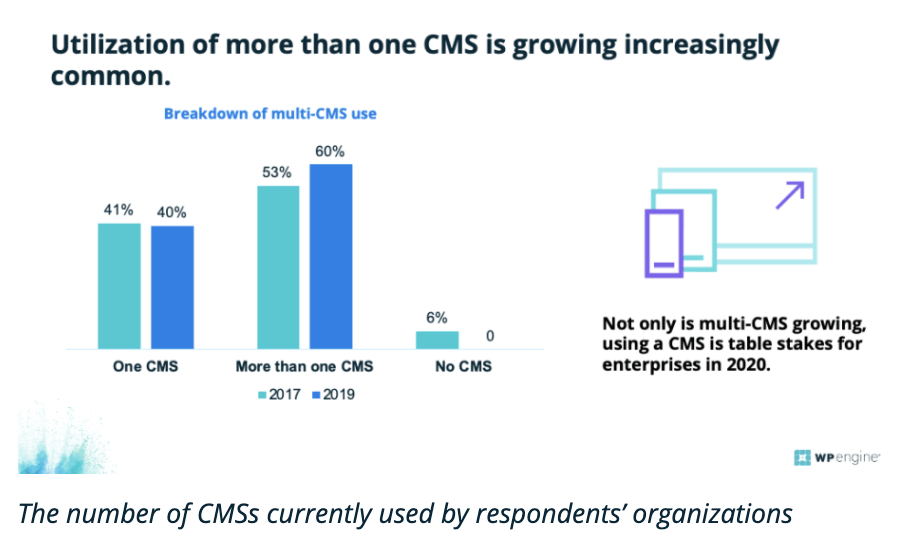
Reinforcing this idea, the vast majority (99%) of surveyed IT and marketing decision-makers acknowledge that using more than one CMS can result in at least one benefit for organizations. Organizations can potentially experience improvements in their agility (48%), as well as greater ease of use (47%), and faster time to market (43%) when working with more than one CMS. Benefits of this nature will inevitably continue to be hugely valuable for organizations as they create and manage increasingly complex digital experiences. What are the benefits for an organization using multiple CMSs?
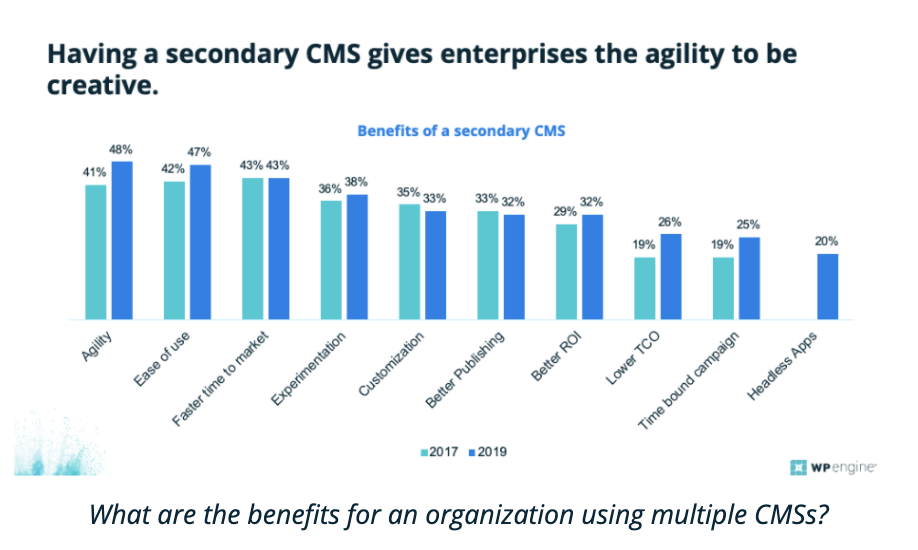
Nonetheless, the multi-CMS approach is not entirely free of potential downsides. An increased need for training (28%) and/or room for error when working across multiple systems (24%) are quite feasible for organizations that branch out into multi-CMS territory. But, crucially, these risk factors are far less likely to be surfaced in 2019 vs. 2017 (33% and 37% respectively).
It seems that fear falls away with familiarity, and as the use of multiple CMSs becomes more normalized in organizations, and as CMS users become more confident using multiple platforms, many of these risks are becoming less of an issue. This is great news for all organizations, as it strongly suggests that in the long term, the pros of such an approach will outweigh the cons.
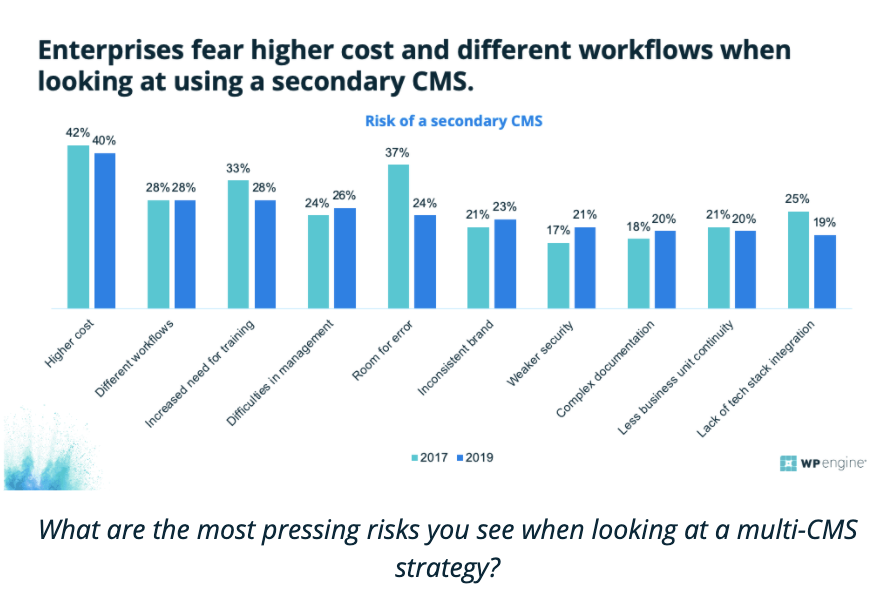
WordPress as a primary or secondary CMS.
For organizations that are using more than one CMS, WordPress has emerged as the favorite option. The vast majority (88%) of respondents whose organizations are already embracing a multi-CMS approach highlight WordPress as part of that mix—more than any other CMS.
88% of respondents whose organizations are already embracing a multi-CMS approach highlight WordPress as part of that mix.
This is undoubtedly due to the wide usability of WordPress and the open source qualities listed previously, but WordPress is also recognized by many as a CMS that has the capacity to work well with and complement other CMSs effectively as well as acting as a standalone CMS. This illustrates the value of WordPress even further, both currently and in the future, as multi-CMS environments become increasingly common in organizations of all sizes.
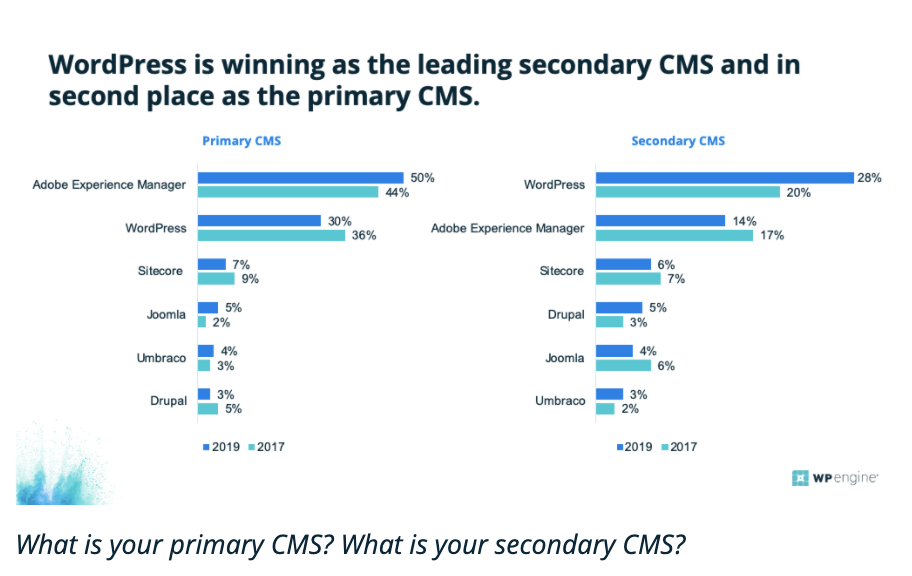
Headless is Here
Just as a growing number of organizations are realizing the benefits of using more than one CMS, CMSs themselves are being used in new, innovative ways.
The term headless is seeing increased use, both as a buzzword and as a viable type of web architecture, in which the front end of a website (the part visible to the end-user) is decoupled from the back end (where the code and data live). More than other “cutting edge” solutions, headless architecture is quickly gaining traction and becoming increasingly significant for many enterprise organizations because it’s secure, and it lets them move lightning fast.
Further, headless approaches eliminate the need for enterprises to re-platform. Companies can keep their legacy infrastructure while APIs navigate touchpoints and unify the customer journey. A customer’s digital experience is never disrupted, even when updates are made on the back end. In short, enterprises keep what they have and make the customer experience better.
It’s for these reasons that headless approaches are already being used for websites in more than half (53%) of respondents’ organizations, and among respondents not already utilizing headless approaches, the vast majority plan to be evaluating headless technology within the next 12 months. Headless in the enterprise is unquestionably here.
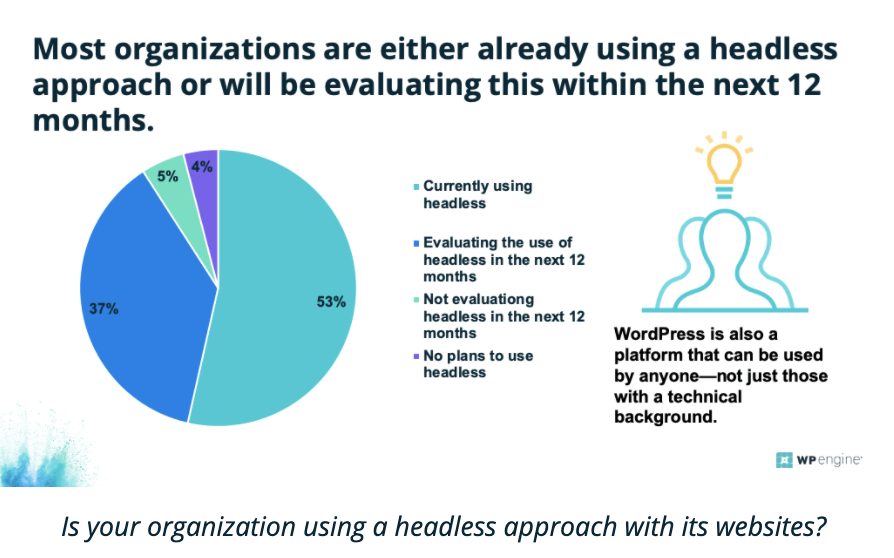
This shouldn’t come as a surprise. As mentioned above, the wide host of benefits associated with headless architecture are driving its widespread adoption. Those benefits touch on much of the speed-to-market and agility that are so critical for organizations today, but other benefits, including security and better visibility into analytics, are actually cited by more respondents.
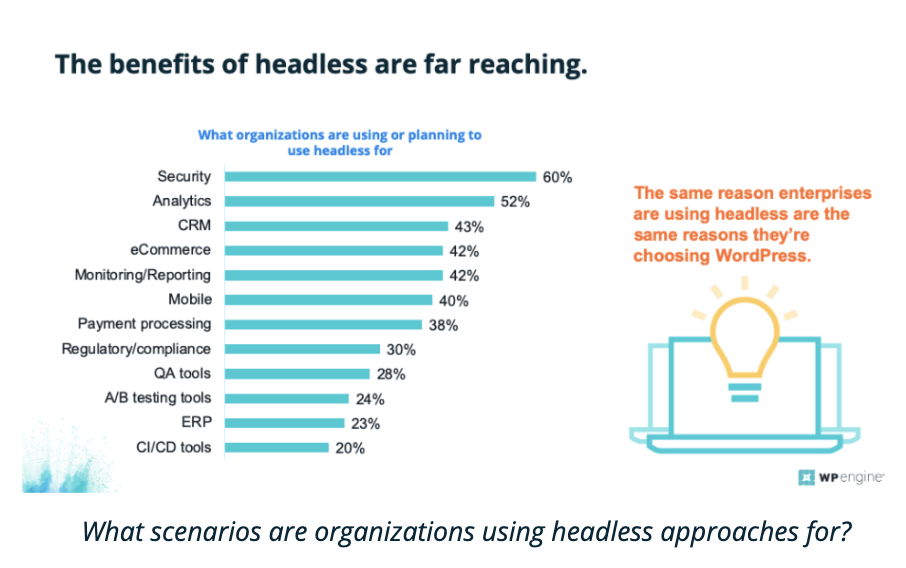
Security is the standout use case for organizations already using headless, with nearly two-thirds (65%) of respondents highlighting security as their primary use for headless. For this particular example, the decoupled nature of headless (i.e. front end and back end are entirely separate) means that if an organization were to encounter an attack on its front end, the attacker would not—by default—gain access to the back end data. In today’s world, where cyberattacks are growing more commonplace and sophisticated, this extra layer of security can be invaluable for any organization, particularly when they need to move quickly in the digital realm.
Elsewhere, other respondents highlight the value that headless approaches have in the context of analytics (50%) as well as monitoring and reporting (44%). Again, the decoupled nature of headless is viewed as an easier way to bolt-on business intelligence systems that can yield critical insights across either customer-facing (from the front end) or internal (from the back end) infrastructures.
Nearly two-thirds (65%) of respondents highlight security as their primary use for headless.
Headless success using a multi-CMS approach.
Another attractive aspect of headless is that organizations don’t need to invest in a specialist headless CMS for success with this type of architecture. In fact, WordPress is by far the most widely used CMS with regard to headless configurations.
Among the organizations already using a headless approach, 65% have WordPress as either their primary or secondary CMS—higher than any other CMS.
Meanwhile, one in four (25%) WordPress users recognize headless applications as being one of its primary benefits. This might not be a massive proportion, but considering the host of other traditional benefits WordPress users are likely to cite, this suggests that headless is making headway, rapidly.
It’s also a clear indication that WordPress is the CMS of choice for those looking to explore the possibilities that headless architecture can deliver.
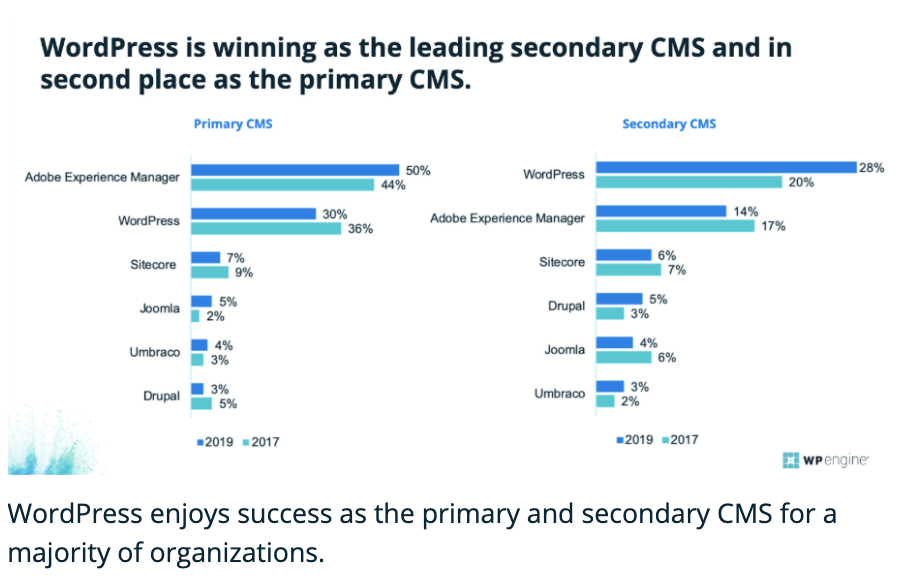
The Future of Multi-CMS
Headless technology will undoubtedly fuel increased adoption of the multi-CMS approach in both the near and not-so-near future, and WordPress specifically will continue to play a major role as either the primary or secondary CMS in headless configurations. But, headless will be one among many emerging technologies that spurs on increased multi-CMS use.
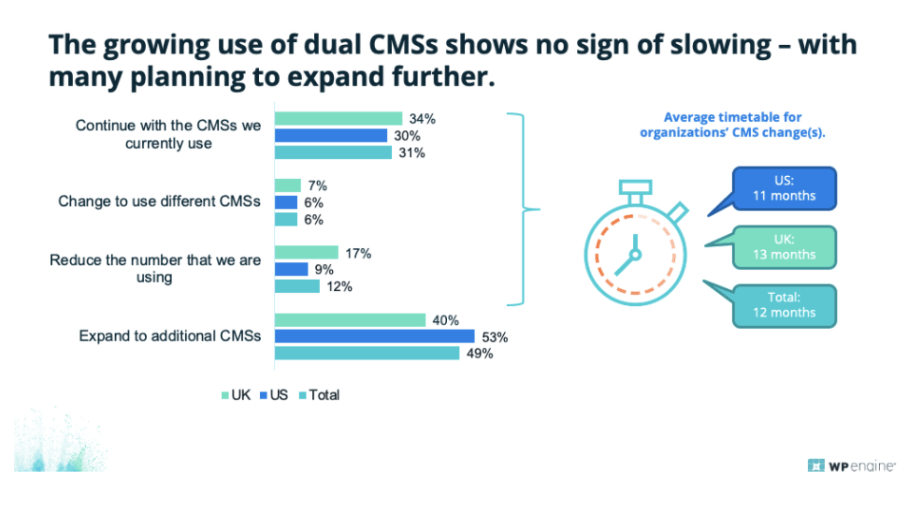
Organizations already plan to expand their use of CMSs in the future, and as the demand to go to market faster increases, and as emerging technologies create the need to experiment and rapidly test out and iterate on new services or new campaigns through micro-targeting, branching away from systems with slow development cycles and crippling vendor lock-in will become an indispensable path forward.
Artificial Intelligence (AI) is one still-emerging field that will generate a greater reliance on the multi-CMS approach. As the AI ecosystem expands, finding the right ways to plug it into digital experiences will become a greater challenge for many organizations. Having the ability to utilize the strengths of different CMSs to deliver AI-powered digital experiences to audiences hungry for things like personalization and websites that can anticipate their likes, wants, and needs will become increasingly valuable.
49% of CMS users plan on expanding to additional CMSs within 12 months.
The new multi-CMS normal.
Today, the digital presence for every business has become too important to manage passively. Everyone is expected to move quickly, and at the enterprise level, moving quickly can be a major challenge.
But the multi-CMS approach offers the speed and agility large businesses need to go to market faster, without replacing legacy systems. That said, choosing the right CMSs—those that complement one another—is crucial.
It’s a close battle at the top between proprietary, closed software and open source solutions.
WordPress and Adobe Experience Manager are neck-and-neck, but this research indicates that WordPress could soon be the frontrunner in terms of enterprise organization use, and it’s already the CMS of choice when used in multi-CMS—and headless—configurations.
Indeed, headless CMS applications are now firmly on the radar for a growing number of organizations. If they aren’t already using headless approaches for their websites, they are likely to adopt them in the near future. Headless may still be relatively nascent in the CMS ecosystem, but enthusiasm for its adoption is extremely high.
Which CMS —proprietary or open source—will provide the enterprise with the greatest agility? What platform will large organizations turn to in order to experiment with new technologies, while maintaining their global web presence at scale?
The good news is, it doesn’t have to be one or the other. Organizations can push ahead of their peers and embrace both solutions without compromise—leveraging benefits from a traditional CMS while achieving agility and flexibility by leveraging additional platforms.
WordPress, more than any other CMS, is at the forefront of enabling this approach.
About WP Engine
WP Engine, the WordPress technology company, provides the most relied upon and trusted brands and developer-centric WordPress products for companies and agencies of all sizes, including managed hosting for WordPress, enterprise hosting, headless WordPress, Flywheel, Local, and Genesis. WP Engine’s tech innovation and award-winning WordPress experts help to power more than 1.5 million sites across 150 countries.
